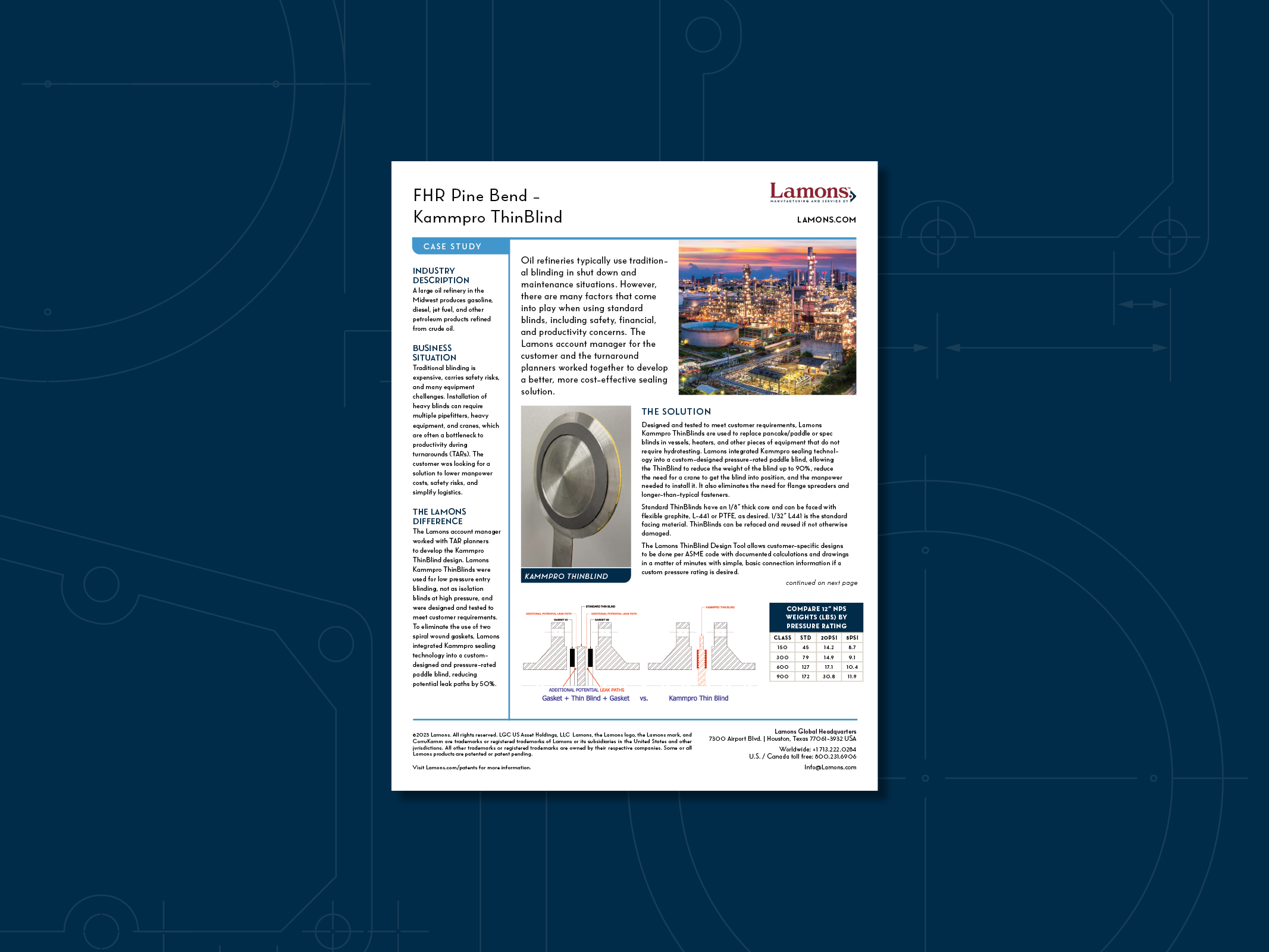
Oil refineries typically use traditional blinding in shut down and maintenance situations. However, there are many factors that come into play when using standard blinds, including safety, financial, and productivity concerns. The Lamons account manager for the customer and the turnaround planners worked together to develop a better, more cost-effective sealing solution.
Industry Description
A large oil refinery in the Midwest produces gasoline, diesel, jet fuel, and other petroleum products refined from crude oil.
Business Situation
Traditional blinding is expensive, carries safety risks, and many equipment challenges. Installation of heavy blinds can require multiple pipefitters, heavy equipment, and cranes, which are often a bottleneck to productivity during turnarounds (TARs). The customer was looking for a solution to lower manpower costs, safety risks, and simplify logistics.
The Lamons Difference
The Lamons account manager worked with TAR planners to develop the Kammpro ThinBlind design. Lamons Kammpro ThinBlinds were used for low pressure entry blinding, not as isolation blinds at high pressure, and were designed and tested to meet customer requirements. To eliminate the use of two spiral wound gaskets, Lamons integrated Kammpro sealing technology into a customdesigned and pressure-rated paddle blind, reducing potential leak paths by 50%.
The Solution
Designed and tested to meet customer requirements, Lamons Kammpro ThinBlinds are used to replace pancake/paddle or spec blinds in vessels, heaters, and other pieces of equipment that do not require hydrotesting. Lamons integrated Kammpro sealing technology into a custom-designed pressure-rated paddle blind, allowing the ThinBlind to reduce the weight of the blind up to 90%, reduce the need for a crane to get the blind into position, and the manpower needed to install it. It also eliminates the need for flange spreaders and longer-than-typical fasteners.
Standard ThinBlinds have an 1/8” thick core and can be faced with flexible graphite, L-441 or PTFE, as desired. 1/32” L441 is the standard facing material. ThinBlinds can be refaced and reused if not otherwise damaged.
The Lamons ThinBlind Design Tool allows customer-specific designs to be done per ASME code with documented calculations and drawings in a matter of minutes with simple, basic connection information if a custom pressure rating is desired.
The Results
ThinBlinds can be, and were, installed much faster, easier, and safer than traditional blinds. ThinBlinds thinner and lighter design made them easier to install and minimized the chance of injury. Not having to handle heavy blinds or heavy rigging reduced back injuries, as well as finger injuries by minimizing pinch points. The integrated seal eliminated the need to use spiral wound gaskets for blinds, resulting in two less items per blinding. This easier handling freed up manpower and removed scheduling conflicts for personnel and equipment to work on other jobs.
In the cited example below, the Turnaround Coordinator faced an unforeseen crude tower overhead replacement but was still able to meet his estimated timeline without interrupting the critical path of the turnaround. He saw substantial cost savings in both blinding activities and crane support needs as a result.
Field Case Study Information
- 30 blinds to be installed
- Cranes, operators, and boilermakers are charged by the hour
- Standard length studs can be used for this low-pressure blinding, removing the need to install new, longer studs
- Flange spreaders with their associated JSA risks were eliminated from the task
Lasting Business Benefits
Optimizing the utilization of skilled labor and reducing downtime has now occurred in over 10 consecutive outages in the last four years. The Kammpro ThinBlind can typically be cleaned, sent back for inspection, refaced, and reused for the next turnaround. Refineries have found a substantial value add in using ThinBlinds as doing so minimizes labor cost, reduces equipment usage, and lowers material cost and safety risks.










